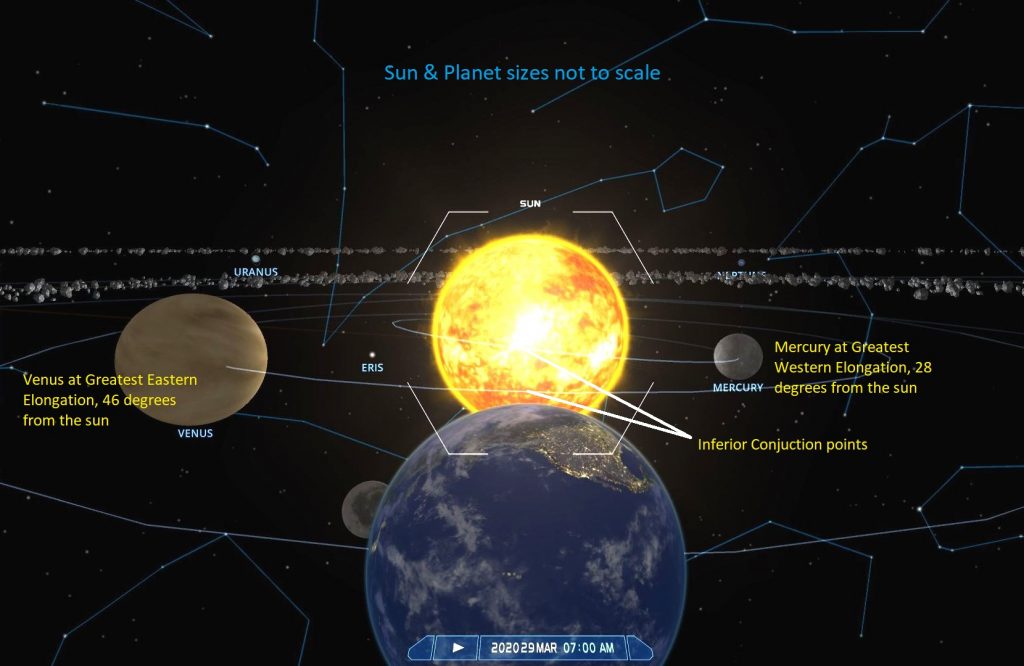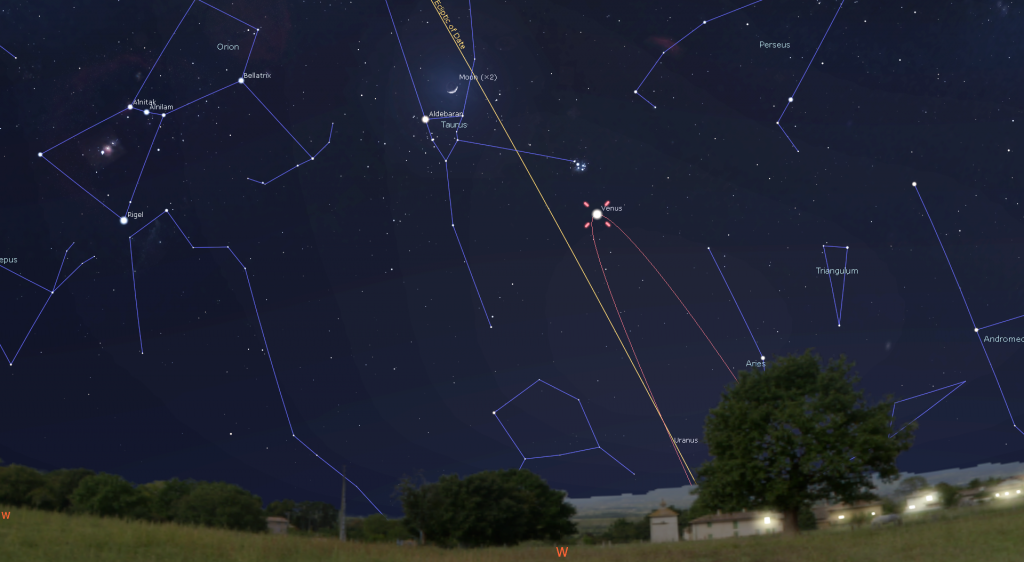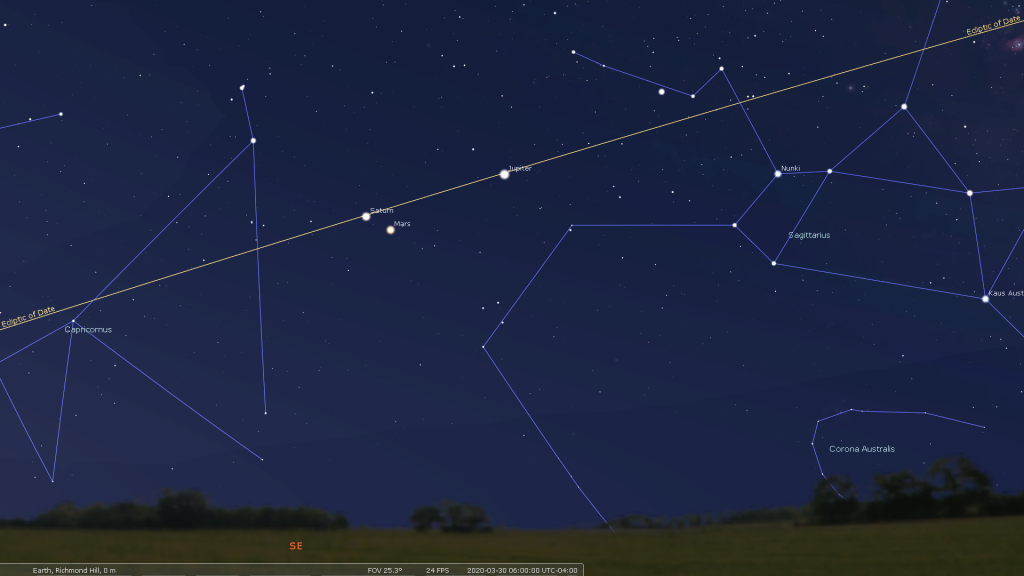A Pretty Moon Every Evening, Morning Mars Swats Saturn, Evening Venus Kisses the Seven Sisters, and Afternoon Astronomy Online!

This composite of many successive images by Kris Smith shows the International Space Station flying across the disk of the full moon.Photographing these transits require careful planning and split-second timing. Another one will occur for Toronto on Saturday evening, April 4, 2020. NASA APOD for Nov 14, 2016.
Hello, April Stargazers!
Here are your Astronomy Skylights for the week of March 29th, 2020 by Chris Vaughan. Feel free to send me your comments, questions, and suggested topics. You can also follow me on Twitter as @astrogeoguy! Unless otherwise noted, all times are expressed in Eastern Time. To receive Skylights by email, please click this MailChimp link.
I can bring my Digital Starlab portable inflatable planetarium to your school or other daytime or evening event. Contact me through AstroGeo.ca, and we’ll tour the Universe together!
The moon will shine prettily in the western evening sky around the world all week long. I explain how the inner planets dance with the sun. Bright Venus will make a rare pass through the Pleiades star cluster on Friday night. With three bright planets remain gathered in the pre-dawn southeast, eastbound Mars will swat Saturn. And the main belt asteroid Juno will reach peak visibility for the year. Here are your Skylights!
Special Space Station Event for the Toronto Area
On Saturday night, April 4 from 8:27 to 8:33 pm EDT, the International Space Station will fly high over Toronto. As a bonus, it will pass directly across the disk of the moon – but only for those watching it along a narrow path that cuts through Toronto. For those not able to get to the centre path for the crossing, the ISS will skim the edge of the moon, or pass close it on the left or right – and that’s still a very cool sight! This link should open a Google map you can zoom in on: https://www.calsky.com/?Transitline=&showhome=&obs=4106347130527775&tdt=2458944.52295044&sat=25544&interval=0.00011574&step=0.00000231&mainbody=10

The moon will be nice and high in the southern sky. The sky will not be completely dark yet.
The space station will cross the moon in mere seconds, so the best approach to capture the memory is to record video of the moon using a camera or smartphone attached to a telescope. An ever better system would be a tracking mount that is following the moon. The passage across the moon is predicted to occur at 8:31:16 pm EDT, give or take. I suggest that you pick a good location, get there well ahead and set up your telescope. Start recording when you see the ISS getting closer to the moon. I’ll post more specifics of the event here.
If you wish to observe this event, please respect social distancing and directives from your local health officials. Events like this do occur from time to time – so we’ll have more chances once the COVID-19 crisis has passed.

Degrees from the Sun?
A reader asked me to elaborate on what I mean when I say Mercury or Venus is a certain number of degrees away from the sun. So let’s dive in – in case others were curious, too. Describing how the inner planets move in our sky is easier with diagrams – so I recommend that you head to the AstroGeo blog post here, to continue reading.
First of all – the word “degrees” refers to the angle measurement, and not the sun’s temperature. It’s too bad scientists didn’t invent different words for those two measurements. The angular separation between two celestial objects is their distance apart in the sky, from your point of view. That separation can be close to zero if they are side-by-side in the sky – or 180 degrees if they are on opposite sides of the sky. And the two objects can be vastly different distances away from you – that doesn’t matter. In simple terms – if you stretch one arm straight towards one object and your other arm straight towards a second object, their angular separation is the angle you are making with your two arms. You can practice doing this with the moon and sun.
We view the planets from our vantage point here on Earth. The two inner planets, Mercury and Venus orbit closer to the sun than we do, and the outer planets, Mars and beyond, orbit farther from the sun than Earth. Because they are closer to the sun than we are, Mercury and Venus can never stray that far away from the sun in the sky. In fact, the angle between Mercury and the sun is always less than 28 degrees, and Venus can’t be farther than 45 degrees from the sun.

Any planet can be positioned near the sun in the sky, but only Mercury and Venus can ever move between Earth and the sun. On those rare occasions when one of them crosses the disk of the sun, its angular separation from the sun is zero! We call that a solar conjunction. At solar conjunction, one can draw a straight line through the Earth, the sun, and that planet. If the planet is between the sun and Earth, it’s called inferior solar conjunction. If the sun is between that planet and Earth it’s a superior solar conjunction.
The rest of the time, those inner planets’ orbits swing them east or west of the sun on a schedule that relates to their orbital period, or year. Mercury’s year is 88 Earth days long. Venus’ year is 225 Earth days. When they are east of the sun, the inner planets follow the sun down after sunset. When they are west of the sun, they rise before the sun. The times when they are farthest away from the sun are called greatest elongations.
With its small orbit, the farthest angle east, or west, that Mercury can ever make with the sun is about 28 degrees. With its short orbit of 88 days, it alternates between maximum east (after sunset) and maximum west (before sunrise) about every 44 days. That’s why Mercury is tricky to see. It is only ever visible before the sun rises, or after the sun sets, usually in a twilit sky. The planet can only be brighter than the sky around it when the sun is well below the horizon – so that means Mercury is only visible while it’s also quite close to the horizon.
Venus’ larger orbit allows it to get to 45 degrees away from the sun, either in the morning or the evening. That bigger angle lets Venus shine high in a dark sky with the sun well below the horizon. Because Venus’ year is only somewhat shorter than Earth’s, and Earth is moving around the sun at the same time, Venus’ morning and evening appearances tend to be longer in duration, happen farther apart, and happen less regularly than Mercury’s.

When inner planets are at their greatest elongations, the sun is shining on them from one side of the other – so viewed in telescopes they show a partial phase, similar to the half-illuminated moon. When those planets move between Earth and the sun, they exhibit thin crescents. And when they move closer to superior conjunction, they show a nearly fully illuminated disk.
The planets that orbit the sun farther from Earth can also experience superior solar conjunctions. At that time we are as far away from them as it’s possible to be. The radio signals to and from our spacecraft at Mars have much longer travel times at superior conjunction, and we often lose their signal altogether when they are very close to the sun.
Those outer planets can also get “behind” us with respect to the sun, and make a 180 degree angle with the sun. Those events are called oppositions. On the nights around opposition, Earth’s distance from each planet is at a minimum – so they appear brightest and largest in telescopes, and they rise as the sun sets. Mars oppositions occur every 27 months. That’s when we send missions there. The next Mars opposition will occur this October.
Since the moon orbits Earth, it can make any angle with the sun. At first and last quarter, the moon is at greatest elongation 90 degrees from the sun. At new moon it is at inferior conjunction. A full moon is at opposition, 180 degrees from the sun.
The Moon and Planets
This is the week of the moon’s cycle when it rises in the afternoon and lingers into the evening sky, perfect for viewing in binoculars and backyard telescopes after dinnertime – all over the world. The sun’s light will be striking the moon at a shallow angle, casting deep black shadows from every bump, mountain, and crater rim – especially along the pole-to-pole terminator boundary line that divides the moon’s lit and dark hemispheres. As the moon waxes fuller every night, and even hour by hour, new zones are highlighted in spectacular fashion.
Grab your binoculars and telescopes for a look at the moon (and Venus). If you have a secure place to put it, set your telescope outside in late afternoon, so it can cool down before you plan to use it. Leave the caps on until you are ready to observe, and replace them before you carry the cold telescope indoors later. You might want to have some alcohol wipes on hand to clean the rubber eye guards on binoculars and telescope eyepieces between users. Pure alcohol shouldn’t hurt your optics – but try not to get hand sanitizer or other disinfectants on your equipment.
This evening (Sunday, March 29) in the western sky, the waxing crescent moon will be positioned above (or to the celestial northeast of) the large open star cluster known as the Hyades. Those stars outline the triangular face of Taurus (the Bull). The moon will also sit to the upper right of bright, orange-tinted Aldebaran. That star, which marks the bull’s left-hand or southerly eye, is less than half as far away as the cluster’s stars. The moon, Aldebaran, and the Hyades will all fit nicely within the field of view of binoculars – with bright Venus and the pretty Pleiades star cluster arrayed to the lower right of them.
The moon will officially reach its first quarter phase on Wednesday, April 1 at 6:21 pm Eastern Time, while it passes through the constellation of Gemini (the Twins). At first quarter, the relative positions of the Earth, sun, and moon will cause us to see the moon half illuminated – on the western (right-hand) side. The term “first quarter” refers not to the moon’s appearance, but the fact that our natural satellite has now completed one quarter of its orbit around Earth, counting from the last new moon.
In the western sky between late evening Thursday and dawn on Friday, the waxing gibbous moon will be positioned less than three finger widths to the right (or 2.5 degrees to the celestial west) of the large open star cluster known as the Beehive or Messier 44 in the constellation of Cancer (the Crab). Observers in western North America will get to see the moon pass just north of the centre of the cluster. The moon passes through, or close to, that cluster frequently because the Beehive is located only 1 degree north of the ecliptic, the track that the moon and planets travel alongside of. To better see the cluster’s stars, try placing the bright moon just outside the field of view of your binoculars.
For the rest of this week, the moon will traverse Leo (the Lion), passing a few finger widths above Leo’s prominent white star Regulus.

In the western sky on the evening of Friday, April 3, Venus’ orbital motion will carry it through the bright Pleiades Star Cluster, otherwise known as Messier 45, the Seven Sisters, the Hole in the Sky, and Subaru. Venus passes that cluster every year – but the orbital mechanics of Earth and Venus only produce Venus traverses of the cluster in a dark sky every eight years, making this event a celestial highlight for 2020. Venus and the cluster will fit together in the field of view of binoculars for several nights surrounding April 3rd, and within the narrower field of backyard telescopes from April 2 to 4, After the event, Venus will climb higher than the Pleiades. Let’s hope for clear skies!

On any night this week, Venus will pop out of the twilight sky at dusk, and then set prior to midnight in your local time zone. If you want to see Venus’ less-than-fully-illuminated disk, aim your telescope at the planet as soon as you can pick it out of the darkening sky. In a twilit sky, Venus’ out-of-round shape will be more apparent. And, when Venus is higher in the sky you’ll be viewing the planet more clearly – through less of Earth’s distorting atmosphere.
Bright planets excitement will continue this week. Jupiter, Mars, and Saturn are lined up in a short chain along the ecliptic in the southeastern pre-dawn sky. Mercury is there, also – but too close to the sun to be seen unless you live near the Equator (or farther south, where the ecliptic is steeper). If you have an open view of the southeastern horizon, though, the three outer planets will be very easy to see with your unaided eyes every morning.

The fun begins at about 4 am in your local time zone. That’s when very bright, white Jupiter will rise. Reddish Mars and medium-bright, yellowish Saturn will rise almost together 15 minutes after Jupiter. Once they climb a little higher, the trio will be nicely visible against a dark sky until about 6:45 am. After that, Mars and Saturn will be lost in the dawn twilight, but Jupiter will remain visible until sunrise.
Mars will pass close to a bright planet for the second time this month when it meets Saturn in the southeastern pre-dawn sky on Tuesday morning. The two planets will have almost the same apparent brightness, but different colors. From Monday to Wednesday, Mars’ faster orbital motion will bring it within a finger’s width below (or one degree to the celestial south of) Saturn. On Tuesday morning, the two planets will be separated by only 55 arc-minutes (the moon’s apparent diameter is 30 arc-minutes). Throughout the encounter, Mars, and Saturn with its rings, will appear together in the field of view of a backyard telescope at high magnification. After Wednesday Mars will continue to race eastward away from the two giant planets, increasing their spread along the ecliptic.

In the Eastern time zone, Jupiter’s Great Red Spot will be in view on Monday morning and Saturday morning.
On Thursday night the major main belt asteroid Juno will reach opposition. At that time, Earth will be passing between the asteroid and the sun, minimizing our distance from Juno and causing it to appear at its brightest and largest for this year. The magnitude 9.5 object will be visible in backyard telescopes all night long. On opposition night, Juno will be positioned below the star Delta Virginis, aka Auva, which marks the northwestern corner of Virgo’s body. One week later, Juno’s motion northward across the foreground stars will bring it within 0.5 degrees of that star, allowing them to appear together in telescopes for several nights.

I’m LiveStreaming Astronomy for Families
Starting this week, I will be hosting free, live daytime astronomy broadcasts geared towards families. It’s in partnership with the Royal Astronomical Society of Canada. The one-hour sessions will run Tuesdays and Thursdays at 3:30 pm EDT. More information, the schedule, and the Zoom link to sign up are all here. If we reach Zoom’s capacity of 500 viewers, you can also watch the sessions on the RASC’s YouTube channel in real time, or later on.
We’re going to start off by learning how to install and set up Stellarium. It’s a fantastic and 100% free astronomy program that I use to prepare my Skylights every week. The kids will love it! If you want to get a head start on that, you can get the download at www.stellarium.org. There’s also an option on that page to use Stellarium Web in a browser. It has fewer features, but no installation will be required.
During our time together, we’ll answer questions from viewers, tour the sky, talk about the Year of Mars, travel through space, and include some astronomy-related scavenger hunts to keep youngsters occupied between sessions. I hope to “see” you there!
Public Astro-Themed Events
Due to the COVID-19 virus, public star parties and lectures have been cancelled or postponed for the moment. Here are some alternate astro-themed activities.
On Wednesday evening, April 1 at 8 pm, The RASC Toronto Centre will run their monthly Recreational Astronomy Meeting online, and everyone is welcome to tune in to watch on their YouTube channel https://www.youtube.com/rasctoronto/live. My friend Blake Nancarrow will deliver The Sky This Month. He always does a terrific job. Tune in!
Many astronomers are running broadcasts of the views through cameras attached to their telescopes while they describe the item and take questions. A search for the terms “star party” on YouTube and FaceBook should let you find live or recorded ones.
The Canadian organization Discover the Universe is offering daily astronomy broadcasts for students called Astro at Home. Their website is here, and their YouTube channel is here.
On many evenings, the University of Toronto’s Dunlap Institute is delivering live broadcasts called Cosmos from Your Couch. The streams can be watched live, or later on their YouTube channel here.
The Perimeter Institute in Waterloo, Ontario has a library of videos from their past public lectures.
Keep looking up, and enjoy the sky when you do. I love questions and requests. Send me some!